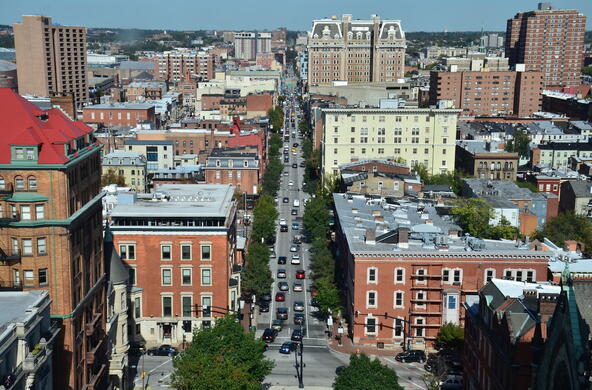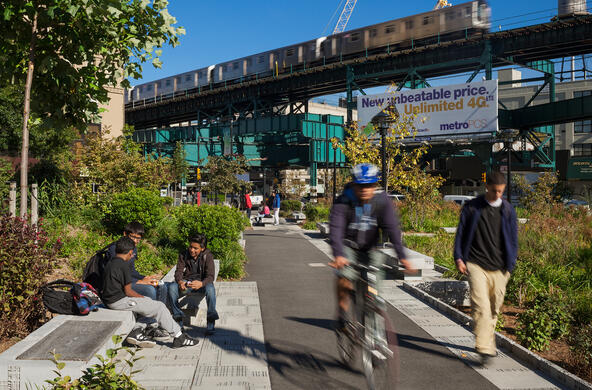Cary Postdoctoral Associate Zbigniew ‘Z’ Grabowski is a socio-ecologist working with Steward Pickett and Timon McPhearson. Z came to Cary from Portland State University, where he earned a PhD in Earth, Environment, and Society – his top-three interests.
Z works with a team of researchers exploring the question: Is green infrastructure a universal good? By analyzing city green infrastructure plans nationwide, this project seeks to determine who green infrastructure affects, and how. Z lives in Washington, DC and holds a visiting faculty position at The New School.
For those new to the topic, what is green infrastructure?
Green infrastructure (GI) refers to natural systems and structures that support our well-being. As a planning concept, GI brings attention to the ways natural and built elements in a landscape interact to perform services that benefit people.
For example: parks facilitate recreation and relaxation, foot and bike paths provide alternative transit, riparian areas mitigate flooding, bioswales manage stormwater, and green roofs cool buildings. A key part of the GI concept is identifying how a single GI element, like a park, can provide multiple functions and benefits in different contexts, like a pandemic.
GI planning must also take into account the diverse needs and experiences of different social groups. These issues raise questions around who benefits and who ‘loses’ as a result of different GI strategies.

What does an average day look like for you?
I read a lot of city sustainability plans to understand how cities define green infrastructure and what that looks like in practice. We ask a lot of questions. Does the plan address ecological processes at the landscape scale? Is green infrastructure being treated primarily as a tool for stormwater management? How is green infrastructure integrated in complex urban systems?
We are also looking at the people involved. Who writes these plans, what are the implications for equity, and are communities involved in the process of planning green infrastructure projects in their neighborhoods? Next, we will evaluate the consequences of the plans.
How did you get involved in science?
My parents came to the US from Poland when I was little. My dad was pursuing his PhD in engineering; my mom undertook a master’s program then completed a PhD in wildlife diseases. So on one side of my family, I grew up in the engineering world, seeing a lot of big computers running fancy models. On the other side, I grew up in dissection rooms, seeing lots of specimens. Early experience with both ‘sides’ helped me learn to look at things in a technical way, but also in a messy biological way.
I’ve always been interested in the social aspects of ecology, whose knowledge ‘counts’, and how ecological principles are applied in governing the world.
When did you know science was what you wanted to pursue as a career?
I’ve always been curious. I wanted to pursue a path where I could freely ask questions and try to find answers. Growing up in an era of climate change and mass extinction, I’ve always asked how we use scientific knowledge to create a better world. As I’ve gotten older, it has become obvious that these sorts of projects are tricky. For whom is the world being made better? For what species? For what groups of humans? Despite these inherent complexities, I still think that a scientific mindset is useful for improving human and ecosystem wellbeing.
Your PhD focused on geography and environmental science. What inspired you to go in that direction?
My education in ecology and evolutionary biology equipped me with great conceptual and analytical tools. However, during my undergraduate studies, I became increasingly dissatisfied with how people were being included in ecological research. I wanted to learn how to better integrate ecology and social sciences. I also wanted to develop a broader skill set around mapping and combining spatial data with policy analysis. Geography and environmental science are both inherently interdisciplinary. They weave together social and ecological concepts and examine interactions and effects. This direction was a natural fit.
What was your fieldwork like?
During my PhD studies at Portland State, I worked on a project looking at ecosystem services in urbanizing regions. This was an opportunity to pursue an interdisciplinary line of inquiry focusing on ecosystem services, while incorporating bigger issues around infrastructure and whose knowledge ‘counts’ in the decision making process.
I ended up focusing on dam removals in the Pacific Northwest and across the country. In the Pacific Northwest, there are a number of watershed councils in various stages of formation. My field work merged traditional aquatic chemistry and water quality monitoring with ‘field’ social science. I did surveys and interviews with people involved in the practice and governance of watershed restoration and dam removals. I got to float rivers, sample snow on volcanoes, and hike deep in the woods. I also set up interviews and went to public meetings to hear conversations about river restoration and dam removal.
Do you have any science heroes?
I draw a lot of inspiration from other scientists, but in a pretty democratic way. I’ve always paid attention to Steward’s work, as someone who is trying to integrate different types of knowledge to study urban ecosystems. I admire people who aren’t afraid to think deeply about these issues, even if it challenges their disciplinary practices and assumptions.
Living in cities over the past decade sparked my interest in issues of equity and green infrastructure. People often think of ecologists as people who go out into the wild to do their research; I think studying how ecological concepts can make cities more livable is just as important.

What made you want to work at Cary?
Cary is an interesting place because it sits outside the confines of big research institutions that tend to come with a lot of bureaucracy, which can be limiting. At Cary, you can ask more focused questions without distraction. I think it’s necessary to have an independent source of knowledge.
A key part of my interest in Cary stemmed from taking a biochemistry seminar with Gene Likens when I was at the University of Connecticut. I was particularly inspired by his role in basic and synthetic research in crafting legislation like the Clean Air Act.
To me, scientists have a responsibility to expose matters of concern in a way that is legible to the public and policy makers. At the same time, we should be directly involved in the process of forming public policy and building mass movements. Why? Ecologists have been paying very close attention to the environmental crisis that we’re all living through. We need to make our knowledge relevant to policy like the Clean Air Act, the Clean Water Act, and the Green New Deal. There is tremendous need for ecological knowledge in those types of decisions.
With unlimited funding, what is your dream project?
My dream project is evolving from the work we are doing now. We are thinking broadly about the social benefits of living in a healthy environment. How does that manifest ecologically and what mechanisms can help us achieve that? My longer term dream would be to combine applied environmental knowledge with regenerative and restorative economic and engineering practices.
Such an approach would seek to restore relations with land in our immediate environments, while participating in a global movement. Right now, we are doing comparative research in the US, but we also need international examples to explore the many different ways of relating to and managing nature across cultures. That’s a dream project: researching how we can achieve environmental quality in different socioecological contexts, while translating that research into policy and practice.
If you were not a scientist, what would you be doing?
When I was little, I wanted to be a professional skier – backcountry skiing, park ranger situation. Now, if I wasn’t doing plan and policy analysis and I didn’t have a child, I would probably be out in the woods running a big permaculture experiment. It would still be science, but more along the lines of what Gregory Cajete defines as ‘Native Science’ – very hands on, the results defined by our experience of the impacts of our work, and not just peer review. I’d be out in the community collaborating with folks, engaging with indigenous communities to learn how to relate to land responsibly.
Any advice to young scientists?
Do what you are most motivated to do, follow your muse. Don’t let other people or funding agencies make that call for you. There are a lot of questions out there, but without an inner spark, answering them will just feel like work.
What is the most difficult and rewarding thing about your job?
The most difficult part of my current job is keeping a lot of information of different types organized in a systematic and transparent way while moving through the tedium of data collection, organization, and analysis. The most rewarding part is when the data is clean and a narrative emerges, and I can communicate results and conclusions, especially with visuals. This piece of my work is so important, to ensure our intensive data collection and number crunching have impact.
What do you do when you’re not working?
I spend a lot of time with my daughter outside, mainly hiking and canoeing. I love mountain biking, white water boating, and looking at and collecting plants. All of it is better when it is local; minimizing drive time is very important to me. I also really enjoy backcountry ski touring, though I don’t get many opportunities to do that in DC. When I’m feeling less active I read, and I’m always interested in playing music with friends that I can groove with. It’s important to take the time to tune in and stay centered.






